
Richard Bell's Wild West Yorkshire nature diary, Friday 3 September 2010

 WE RESIST the temptation to use the digital camera; we've never seen Fylingdales Moor so purple with heather but we drove on without pulling up to record the scene and in the afternoon we would have made slow progress along the beach from Sandsend if we had stopped for everything that was worth a photograph but I can't entirely resist beachcombing, so I pick up this carapace of an edible crab, Cancer pagurus, and draw it back at the bed and breakfast. You can identify the edible crab by the piecrust edging to its carapace.
WE RESIST the temptation to use the digital camera; we've never seen Fylingdales Moor so purple with heather but we drove on without pulling up to record the scene and in the afternoon we would have made slow progress along the beach from Sandsend if we had stopped for everything that was worth a photograph but I can't entirely resist beachcombing, so I pick up this carapace of an edible crab, Cancer pagurus, and draw it back at the bed and breakfast. You can identify the edible crab by the piecrust edging to its carapace.
There was a small mussel inside it. I wondered if it had adopted the inside of the shell as a hard substrate on which to settle, only to find itself high and dry when the shell was washed ashore.
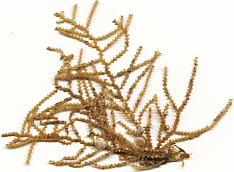
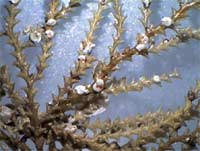 In a similar way, dozens of tiny molluscs had been clinging to the wreckage of this branched colonial animal that looked like a piece of dry brittle feather moss when I picked it up on the beach. The scan (left) is life size. When I looked at it with a magnifying glass I could see small coiled shells attached to its branches (right).
In a similar way, dozens of tiny molluscs had been clinging to the wreckage of this branched colonial animal that looked like a piece of dry brittle feather moss when I picked it up on the beach. The scan (left) is life size. When I looked at it with a magnifying glass I could see small coiled shells attached to its branches (right).
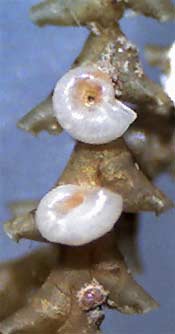
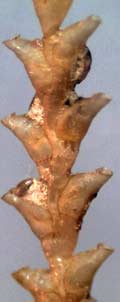
Under the microscape you can see the individual flask-like cells in which the creatures lived. It reminds me of the saw-toothed colonies of graptolites; the fossilised creatures of prehistoric seas, except with them the cells were lined up along one edge only.
At 60x, the microscope showed not only the snail-like mollusc shells visible through the magnifying glass but also smaller grey scale-like shells cemented to the cells (right, bottom).
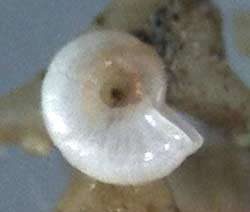
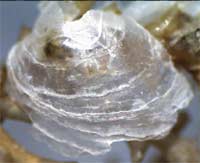 Zooming in to a maximum of 200x enabled me to photograph the 'snail' shell and a bivalve shell that looks like a transparent version of a mussel (right).
Zooming in to a maximum of 200x enabled me to photograph the 'snail' shell and a bivalve shell that looks like a transparent version of a mussel (right).